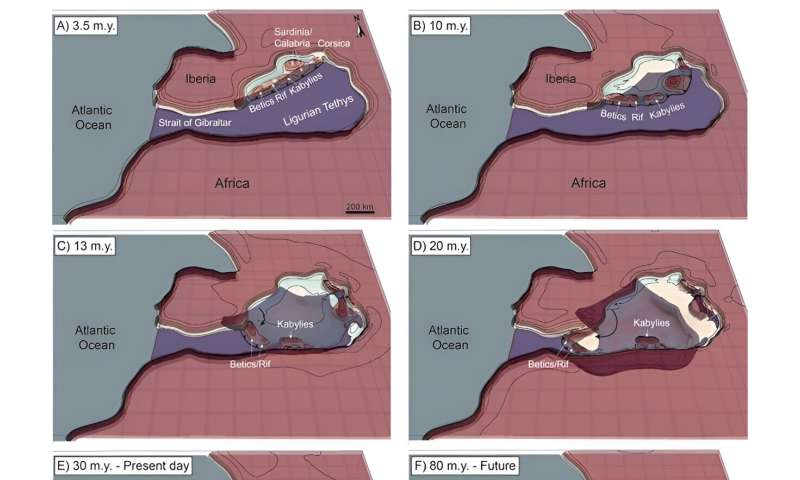This article has been reviewed according to Science X's editorial process and policies. Editors have highlighted the following attributes while ensuring the content's credibility:
fact-checked
trusted source
proofread
How do oceans start to close? New study suggests the Atlantic may 'soon' enter its declining phase

A new study, resorting to computational models, predicts that a subduction zone currently below the Gibraltar Strait will propagate further inside the Atlantic and contribute to forming an Atlantic subduction system—an Atlantic ring of fire. This will happen 'soon' in geological terms—in approximately 20 million years.
Oceans seem eternal to our lifespan, but they are not here for long: they are born, grow, and one day close. This process, which takes a few hundred million years, is called Wilson Cycle. The Atlantic, for example, was born when Pangea broke up around 180 million years ago and will one day close. And the Mediterranean is what remains from a big ocean—the Tethys– that once existed between Africa and Eurasia.
For an ocean like the Atlantic to stop growing and start closing, new subduction zones—places where one tectonic plate sinks below another—have to form. But subduction zones are hard to form, as they require plates to break and bend, and plates are very strong. A way out of this "paradox" is to consider that subduction zones can migrate from a dying ocean in which they already exist—the Mediterranean—into pristine oceans—such as the Atlantic. This process was dubbed subduction invasion.
This study shows for the first time how such a direct invasion can happen. The computational, gravity-driven 3D model predicts that a subduction zone currently below the Gibraltar Strait will propagate further inside the Atlantic and contribute to forming an Atlantic subduction system—an Atlantic ring of fire, in an analogy to the already existing structure in the Pacific. This will happen 'soon' in geological terms—but not before approximately 20 million years.
"Subduction invasion is inherently a three-dimensional process that requires advanced modeling tools and supercomputers that were not available a few years ago. We can now simulate the formation of the Gibraltar Arc with great detail and also how it may evolve in the deep future," explains João Duarte, first author and researcher at Instituto Dom Luiz, at the Faculty of Sciences of the University of Lisbon.

This study sheds new light on the Gibraltar subduction zone, as few authors considered it to be still active because it has significantly slowed down in the past million years. According to these results, its slow phase will last for another 20 million years and, after that, will invade the Atlantic Ocean and accelerate. That will be the beginning of the recycling of crust on the eastern side of the Atlantic and might be the start of the Atlantic itself beginning to close.
"There are two other subduction zones on the other side of the Atlantic—the Lesser Antilles, in the Caribbean, and the Scotia Arc, near Antarctica. However, these subduction zones invaded the Atlantic several million years ago. Studying Gibraltar is an invaluable opportunity because it allows observing the process in its early stages when it is just happening," adds João Duarte.
-

Map highlighting the Atlantic subduction zones, the fully developed Lesser Antilles and Scotia arcs on the western side and the incipient Gibraltar arc on the eastern side. From Duarte et al., 2018. Credit: João C. Duarte -

Maps showing the evolution of the Gibraltar subduction zone from 30 million years ago to 50 million years into the future. From Duarte et al., 2024. Credit: João C. Duarte
Broadly, this study shows that subduction invasion is likely a common mechanism of subduction initiation in Atlantic-type oceans and thus plays a fundamental role in the geological evolution of our planet.
The finding that the Gibraltar subduction is still currently active has also important implications for seismic activity in the area. Subduction zones are known for producing the strongest earthquakes on Earth. Events such as the 1755 Great Lisbon Earthquake are a threat and require preparedness.
The work is published in the journal Geology.
More information: João C. Duarte et al, Gibraltar subduction zone is invading the Atlantic, Geology (2024). DOI: 10.1130/G51654.1
Provided by University of Lisbon





















